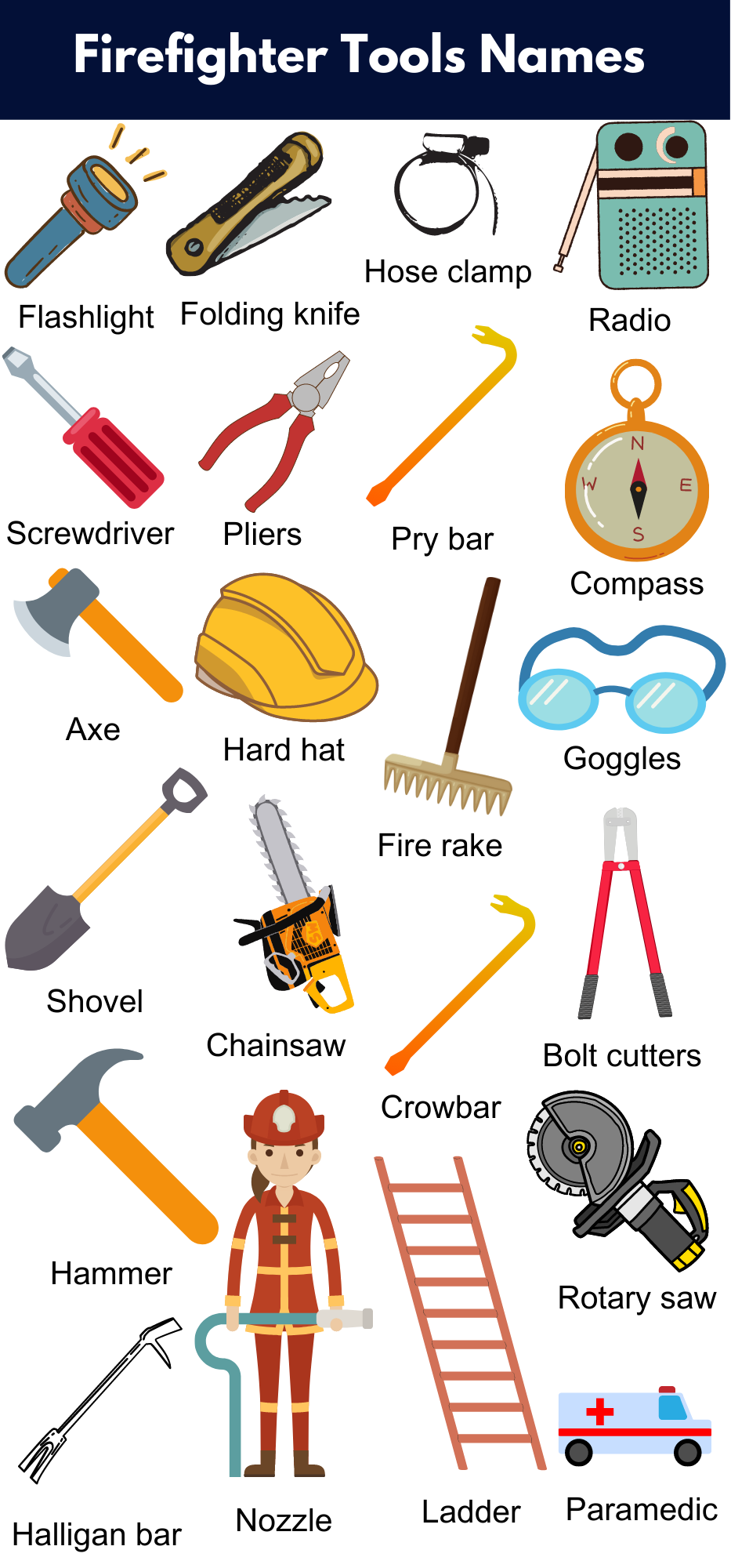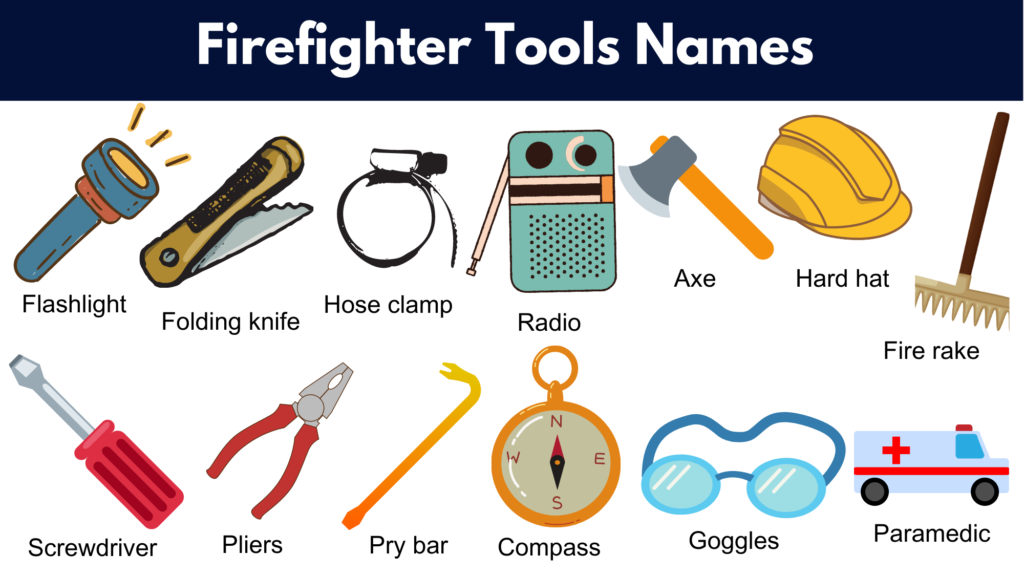As a firefighter, having the right tools at your disposal can make all the difference in effectively responding to emergency situations. Whether it’s a house fire, a car accident, or a hazardous material spill, carrying the right tools can mean the difference between life and death. In this blog post, we’ll provide you with a comprehensive list of firefighter tools name that you should carry with you at all times. From hand tools to power tools, we’ll cover everything you need to know to ensure you’re well-equipped to handle any emergency situation. So, let’s get started and take a closer look at some of the most important tools for firefighters.
Firefighter Pocket Tools
Firefighters rely on a variety of pocket tools to help them perform their jobs safely and efficiently. Here are some of the most commonly used firefighter pocket tools:
- Flashlight
- Folding knife
- Radio
- Pocket-sized fire extinguisher
- Hose clamp
- Resuscitation mask
- Carabiner clip
- Thermal imaging camera
- Screwdriver
- Mini Halligan tool
- Pry bar
- Pliers
- Window punch
- Personal alarm
- Seatbelt cutter
- Compass
- Gas shut-off tool
- Wedge
- Emergency whistle
- Multi-tool
Wildland Firefighter Tools
Here’s a list of wildland firefighter tools names:
- Axe
- Water
- Boots with steel toes and shanks
- Earplugs
- Hard hat
- Brush hook
- Fire rake
- Goggles
- Nomex clothing
- Personal Alert Safety System (PASS)
- McLeod tool
- Shovel
- Pulaski tool
- Drip torch
- Flappers
- Water backpack
- Handheld drip torch
- Chainsaw
- Fire shelter
- Bladder bag
- Leather gloves
Firefighter Entry Tools
- Bolt cutters
- Ladder
- Sledgehammer
- Nozzle
- Crowbar
- Glass breaker
- Lock pick set
- K-12 saw
- TIC (Thermal Imaging Camera)
- Hooligan tool
- Hydraulic cutter
- Hammer
- Breaching saw
- Halligan bar
- Rotary saw
- Hydraulic spreader
- Jaws of Life (Hydraulic Rescue Tools)
Firefighter Tools and Uses
Here’s a list of common firefighting tools in alphabetical order along with their uses:
Aerial Ladder: A long ladder mounted on a truck that can be extended up to several stories to provide access to elevated areas.
Axe: A handheld tool with a sharp metal blade used for chopping, breaking, and cutting.
Breathing Apparatus: A device worn on the face to supply fresh air to the firefighter while working in a smoke-filled environment.
Crowbar: A metal bar used to pry open doors or windows to gain access to buildings.
Halligan Tool: A multi-purpose tool that consists of a pick, a flathead, and a forked end used for forcible entry and ventilation.
Hose: A long, flexible tube used to transport water or other extinguishing agents to the fire.
Hydrant Wrench: A tool used to open and close fire hydrants to control the flow of water.
Jaws of Life: A hydraulic tool used to pry apart or cut through metal in order to rescue people trapped in vehicles or buildings.
Pike Pole: A long pole with a pointed end used to break through walls or ceilings to ventilate a burning structure.
Portable Pump: A gasoline-powered pump used to draw water from a source such as a hydrant, pool or pond to supply water to hoses.
Protective Clothing: A set of clothing, including a helmet, coat, pants, gloves, and boots, that protects firefighters from heat, flames, and other hazards.
Radio: A communication device used to coordinate firefighting efforts and keep in contact with other team members.
Sledgehammer: A heavy-duty hammer used to break through walls or ceilings.
Thermal Imaging Camera: A device used to detect heat signatures and locate hot spots within a burning building.
Water Nozzle: A handheld device that attaches to a hose and is used to control the flow and direction of water.
These are some of the most common firefighting tools used by firefighters in the field. However, the exact tools used may vary depending on the specific needs of the situation.
Tips for Choosing the Right Firefighter Tools
Choosing the right firefighter tools is crucial for ensuring the safety and effectiveness of firefighting operations. Here are some tips to consider when selecting firefighter tools:
Quality and Durability: Look for tools that are made from high-quality materials and designed to withstand the demanding conditions of firefighting. Tools should be sturdy, durable, and able to withstand heat, water, and other harsh environments.
Ergonomics: Firefighters often have to carry and operate tools for extended periods. Choose tools that are ergonomically designed and comfortable to handle. They should have non-slip grips, be lightweight, and have balanced weight distribution to minimize fatigue and maximize efficiency.
Functionality: Assess the functionality of the tools and ensure they meet the specific needs of firefighting. Consider the type of fires typically encountered, the tasks performed, and the specific roles of the firefighters. Tools should be versatile and suitable for various situations.
Safety Features: Safety should be a top priority when selecting firefighter tools. Look for tools that have built-in safety features to protect firefighters during use. For example, tools with insulated handles to prevent electrical conductivity or tools with non-sparking properties for working in explosive environments.
Maintenance and Repair: Consider the ease of maintenance and availability of spare parts for the tools. Firefighter tools should be easy to clean, inspect, and maintain to ensure they remain in good working condition. Additionally, check if the manufacturer provides repair services or if replacement parts are readily available.
Compatibility: If you already have existing firefighting equipment, ensure that the new tools are compatible and can be integrated with the existing systems. This will help maintain consistency and avoid compatibility issues during operations.
Training and Familiarity: Consider the familiarity and training required for using the tools. Select tools that are widely used and standardized within the firefighting community. This ensures that firefighters are familiar with their operation and can efficiently utilize them during emergencies.
Budget Considerations: While quality and functionality should be the primary factors, it’s important to consider your budget constraints. Evaluate the cost-effectiveness of the tools, taking into account their long-term durability and performance.
Feedback and Reviews: Research and gather feedback from other firefighting professionals or departments regarding the tools you are considering. Reviews from experienced firefighters can provide valuable insights into the performance and reliability of different tools.
Standards and Regulations: Ensure that the tools meet the relevant safety standards and regulations set by firefighting organizations or regulatory bodies in your region. Compliance with these standards ensures that the tools have undergone testing and meet the necessary requirements for firefighting operations.
Remember that selecting the right tools is not a one-size-fits-all approach. Consider the specific needs and requirements of your firefighting operations and consult with experienced firefighters or equipment specialists to make informed decisions.
Also Learn: List of Photography Vocabulary Words
Fireman Tools Pictures with Names




